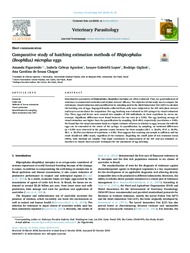Comparative study of hatching estimation methods of Rhipicephalus (Boophilus) microplus eggs.
Comparative study of hatching estimation methods of Rhipicephalus (Boophilus) microplus eggs.
Author(s): FIGUEIREDO, A.; AGNOLON, I. C.; LOPES, L. G.; GIGLIOTI, R.; CHAGAS, A. C. de S.
Summary: Reproductive parameters of Rhipicephalus (Boophilus) microplus are often evaluated. They are good indicators of resistance to commercial acaricides and of plant extracts? efficacy. The objective of this study was to compare the techniques: visual estimation and quantification by sampling used in the Adult Immersion Test (AIT) to calculate the hatching rate of eggs. Engorged females collected from cattle were subjected to the AIT with plant extracts and kept in an incubator for oviposition. The egg hatching was evaluated in 210 syringes by visual estimation (%). Then, eggs and larvae were counted into samples of 100 individuals, in three repetitions by stereo microscope. Significant differences were found between the two tests (p?0.05). The egg hatching average of visual estimation was higher than the quantification by sampling, 56.8?48.0, respectively (correlation=0.85). We found that the visual assessment leads to a higher estimate of larvae in relation to eggs, because the infertile eggs can be concealed in the center of the syringe. In quantification by sampling, no statistical differences (p=0.99) were observed in the pairwise counts between the three samples (48.1 ± 26.6%, 47.8 ± 26.9%, 48.1 ± 26.5%) (correlation of repetitions=0.96). This suggests that counting one sample is sufficient and the result should not differ much, regardless of the evaluator. Regarding the cutoff point of tick resistance status (95%), both methods are reliable. This study contributes to improvement of the AIT and can stimulate researchers to choose more accurate techniques for the assessment of egg hatching.
Publication year: 2018
Types of publication: Journal article
Observation
Some of Embrapa's publications are published as ePub files. To read them, use or download one of the following free software options to your computer or mobile device. Android: Google Play Books; IOS: iBooks; Windows and Linux: Calibre.
Access other publications
Access the Agricultural Research Database (BDPA) to consult Embrapa's full library collection and records.
Visit Embrapa Bookstore to purchase books and other publications sold by Embrapa.

